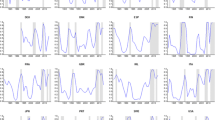Abstract
The objective of this paper is to determine whether ERM-participating countries have experienced a change in the effectiveness of monetary and fiscal policies since the establishment of the ERM. Countries which have come to rely more heavily on fiscal policy instruments as the means of output, price and exchange rate stabilization since the establishment of the ERM (and currently exceed the fiscal criteria) are expected to find the Maastricht fiscal criteria restrictive and perhaps destabilizing. We find that Belgium, Italy and Ireland are the countries that are likely to face the most difficulties.
Similar content being viewed by others
References
Agell, J., L. Calmfors, and J. Johsson (1994)“Fiscal Policy When Monetary Policy is Tied to the Mast,” Institute for International Economic Studies. Seminar Paper No. 564.
Bayoumi, T. (1992) “The Effect of the ERM on Participating Economies,” IMF Staff Papers 39, 330–356.
Buiter, W., G. Corsetti, and N. Roubini (1992) “Excessive Deficits: Sense and Nonsense in the Treaty of Maastricht,” CEPR Discussion Paper No. 750.
De Grauwe, P. (1994)The Economics of Monetary Integration. Oxford University Press.
Giavazzi, F. and A. Giovannini (1989) Limiting Exchange Rate Flexibility. MIT Press.
Giavazzi, F. and M. Pagano (1988) “The Advantage ofTying One's Hand: EMS Discipline and Central Bank Credibility,” European Economic Review 32, 1055–1075.
Herz, B. and W. Roger (1992) “The EMS is a Greater Deutschmark Area,” European Economic Review 36, 1413–1425.
Judge G., W.E. Griffiths, H.Carter Hill, Helmut Lutkepohl, and Tsoung-Chao Lee (1985) The Theory and Practice of Econometrics, 2nd ed., John Wiley and Sons.
Karfakis, C. and D. Moschos (1990) “Interest Rate LinkagesWithin the European Monetary System: A Time Series Analysis,” Journal of Money, Credit and Banking 22(3), 388–94.
Keating, J. (1992)“Structural Approaches to Vector Autoregressions,” Review, FRB of St. Louis 74, 37–57.
Kenen, Peter (1992)“EMU After Maastricht,” Group of 30.
Kretzmer, P.(1992) “How Important are Monetary and Fiscal Policy in Explaining Postwar Aggregate U.S. Data? A Vector Autoregressive Approach,” Working paper, Federal Reserve Bank of Kansas City.
Author information
Authors and Affiliations
Rights and permissions
About this article
Cite this article
Fountas, S., Papagapitos, A. Policy Effectiveness in the Post-ERM Era: Evidence from Six Countries. Open Economies Review 8, 189–201 (1997). https://doi.org/10.1023/A:1008241116488
Issue Date:
DOI: https://doi.org/10.1023/A:1008241116488




